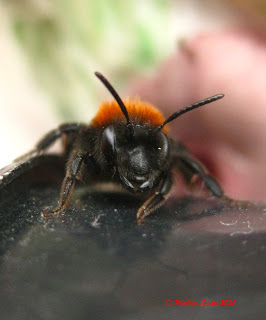 Although quite grey and not very warm, I decided today to cycle into the countryside near where we live. As I understand it we're allowed to exercise locally as long as you social distance with anyone you meet, so off I went on some little used country lanes to see what wildlife was about.
Although quite grey and not very warm, I decided today to cycle into the countryside near where we live. As I understand it we're allowed to exercise locally as long as you social distance with anyone you meet, so off I went on some little used country lanes to see what wildlife was about.Quite a few farmers were busy sowing seed and spraying early crops and I did meet (but across the road from!) a few people out walking and cycling. But most of the time I was alone and with a lot less ambient noise from traffic, it was lovely to just hear birdsong.
More chiffchaffs (Phylloscopus collybita) heard and seen today, five I think in total. They are, even at this time of year with little growth on the trees, still very difficult to see and tend to sing from high branches and only seen when they move elsewhere.
A hamlet I go through regularly (and there's very few people about even in normal times!) is Catterton, and since my last visit a field on the edge of the village has been split up for smallholding with an area for chickens and another area for a very interested and smiley goat!
Goats seem to be in the news today after a herd has decided to take over Llandudno in Wales!
Goats will eat anything they can!
This isn't a very good photo of a brown hare, but in general I have found them skittish and only seen at a distance. I did see two chasing each other round a field earlier in the ride. I've only ever once seen two hares "boxing", and this is why they do it
https://www.woodlandtrust.org.uk/blog/2019/03/why-do-hares-box/
Chaffinches (Fringilla coelebs) are ubiquitous in the hedgerows in the areas I ride in. They either live in noisy groups or a male will sit on a wire or hedge shrieking for ages. They are often very inquisitive and quite tame at picnic benches. On one holiday in Glen Nevis we had chaffinches tapping on the window of the holiday cottage every morning wanting food!
Also common around here are Yellowhammers (Emberiza citrinella) although I've not noticed any of them singing their notes to "a-little-bit-of-bread-and-no-cheese" yet
 Askham Richard is a pretty village with a duckpond. The ducks are very inbred and cross bred with feral ducks now and look a little mixed up. Today was the first time I have seen Canada Geese on here. Almost all the Canada Geese seen in the UK are descendants of introduced ones a century or two back, very occasionally a truly wild one from Canada will fly in with winter geese flocks.
Askham Richard is a pretty village with a duckpond. The ducks are very inbred and cross bred with feral ducks now and look a little mixed up. Today was the first time I have seen Canada Geese on here. Almost all the Canada Geese seen in the UK are descendants of introduced ones a century or two back, very occasionally a truly wild one from Canada will fly in with winter geese flocks.Also seen on my ride was a Reed Bunting, and Linnets and Skylarks, the latter are singing away in the sky and very hard to spot once they are up there!















